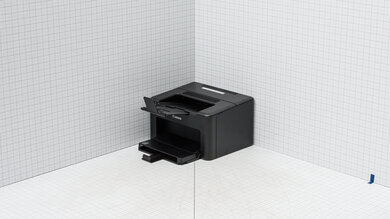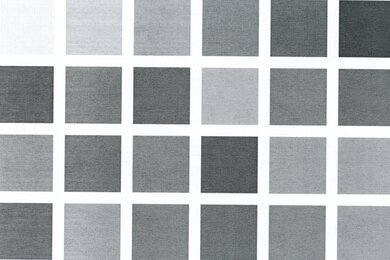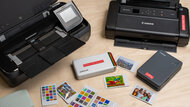The Canon imageCLASS LBP122dw is a monochrome laser printer. It's a print-only unit with Wi-Fi, Ethernet, and USB connectivity and support for AirPrint and Mopria Print Service. It's compatible with 071 standard format or 071 H high-yield cartridges. It also features a 150-sheet input tray, a 100-sheet output tray, and a small monochrome LCD display.
Our Verdict
The Canon imageCLASS LBP122dw is a poor fit for family usage. It can only print in black-and-white, and its highly-pronounced printing pattern makes it unsuitable for printing documents that incorporate photos or detailed graphs. It also lacks a scanner to copy pages from books or magazines. That said, the relatively wide range of connectivity options makes it easy for anyone in your home to connect to the unit, and its high page yield keeps ownership costs low.
- High page yield and low cost-per-print.
- Few maintenance requirements.
- Printing pattern obscures fine details.
- Can't print in color.
- Can't print on glossy paper.
- No scanner.
The Canon imageCLASS LBP122dw is an okay choice for home offices. While printing quality is nothing to write home about, with poor resolution of fine details and a lot of graininess, the LBP122dw can output a large number of black-and-white pages in remarkably little time. Its toner cartridge has a high yield, so you won't have to replace it very often, which keeps the cost of ownership low. That said, the lack of a scanner and color printing capability might be limiting to some offices.
- High page yield and low cost-per-print.
- Fast printing speed.
- Few maintenance requirements.
- Can't print in color.
- No scanner.
- Mediocre document printing quality.
The Canon imageCLASS LBP122dw is a decent choice for students as long as you know its limitations. It can't print in color and is best suited for bulk printing text documents, as its obvious printing pattern can obscure fine details in photos and graphs. It lacks a scanner, too, so you'll have to look elsewhere if you frequently need to copy from textbooks. That said, it can quickly print long, multi-page documents, which is great for those last-minute essay submissions. Its relatively inexpensive replacement toner cartridges and high page yield also mean low ownership costs.
- High page yield and low cost-per-print.
- Fast printing speed.
- Few maintenance requirements.
- No scanner.
- Mediocre document printing quality.
The Canon imageCLASS LBP122dw is a good black-and-white printer. Even its standard-format 071 toner cartridge has a high page yield, though you can buy a high-yield cartridge if need be. The printer also outputs pages very quickly. That said, print quality is mediocre; while text is legible, there's a lot of graininess, and details in photos and graphs are obscured by the low print resolution and obvious printing pattern.
- High page yield and low cost-per-print.
- Fast printing speed.
- Mediocre document printing quality.
The Canon imageCLASS LBP122dw isn't designed for photo printing. It's a black-and-white-only laser unit, so it can't print in color. Its low print resolution and obvious printing pattern result in photos that look grainy and lacking in detail.
- Printing pattern obscures fine details.
- Can't print in color.
- Can't print on glossy paper.
Performance Usages
Changelog
- Updated Jan 16, 2025:
We've updated the product's 'Depth When In Use' in the Dimensions section to correct an error.
- Updated Sep 29, 2023: Review published.
- Updated Sep 26, 2023: Early access published.
- Updated Sep 21, 2023: Our testers have started testing this product.
Check Price
Differences Between Sizes And Variants
There are a few other variants of this printer with slight differences in name, region of sale, and connectivity options.
| Model Name | Region of Sale | Connectivity |
|---|---|---|
| imageCLASS LBP122dw | North America | USB, Wi-Fi, Ethernet |
| i-SENSYS LBP122dw | Europe | USB, Wi-Fi, Ethernet |
| imageCLASS LBP121dn | Asia | USB, Ethernet |
We tested the imageCLASS LBP122dw variant, and you can see its label here.
Let us know in the discussions if you come across another variant of this printer, and we'll update our review.
Popular Printer Comparisons
The Canon imageCLASS LBP122dw is a basic print-only monochrome laser unit. Compared to similarly-priced models like the Pantum P2502W, it feels considerably better built and offers niceties like automatic duplex printing and an LCD status display, though it's worth noting that the latter is really rudimentary. Its page yield is fairly high, though not class-leading amongst other laser printers, and its mediocre document printing quality means that it's best suited for text-only documents.
If you're looking for an alternative, see our recommendations for the best laser printers, the best office printers, and the best black and white printers.
The Canon imageCLASS LBP122dw is better than the Pantum P2502W. While the Pantum has a marginally higher page yield, the Canon has many other advantages on its side. The Canon feels better built, prints faster, and has an Ethernet port and a basic LCD status screen.
The Brother HL-L2325DW and Canon imageCLASS LBP122dw are both monochrome print-only units with different strengths. The Brother offers noticeably superior print quality for documents that occasionally incorporate photos or graphs. That said, the Canon prints faster, uses toner cartridges with a higher page yield, and incurs lower ownership costs, so it's a better option for bulk printing of text documents.
The Canon imageCLASS LBP122dw is a better printer than the Canon imageCLASS MF3010. The LBP122dw feels noticeably sturdier, has a slightly more informative status screen, supports duplex printing, and offers a wide range of wireless printing options that the MF3010 does not, including Wi-Fi as well as Apple AirPrint and Mopria Print Service. The MF3010 holds an advantage with its flatbed scanner, so it could be a better fit if you don't mind the lack of wireless connectivity and frequently copy from textbooks or magazines. It also uses cartridges with a much higher page yield than the 071 format cartridges used by the LBP122dw.
Test Results

This printer feels well-built. It's made of fairly dense plastic and has no obvious weak points. It also has a detachable power cable and solid-feeling input connections. The LBP122dw features adjustable sliders to align sheets and prevent paper jams; they're easy to move and have distinct notches corresponding to different paper sizes. The input tray has a cover to protect any paper inside and can be tucked away. Opening the top of the printer gives you easy access to the toner cartridge, but note that there's no damper for the lid, so it'll slam shut if you don't gently close it. If you want to access the sheet rollers, you can open the panel at the rear of the printer, as seen here.
The Canon imageCLASS LBP122dw doesn't require much maintenance, as unlike an inkjet printer, there's no risk of printhead clogging. That said, if you encounter any print quality issues, you can resolve them by running the built-in 'Cleaning the Fixing Assembly' or 'Cleaning the Drum' routines in the printer menu. The toner cartridge's high yield ensures you won't need to replace it too often. Replacing the cartridge is pretty simple, with the top cover opening wide to give you ample access to the printer's internals. The drum is also built into the cartridge, so there's no need to replace it separately. The input tray holds 150 sheets of paper, so depending on how much you print, you may need to refill it regularly.
You can see the online manual here.
This printer's display is pretty simple. It's a small monochrome LCD that roughly estimates the remaining toner levels and Wi-Fi connectivity status. Its reflective surface, low brightness, and fixed position make it very hard to see, even when looking at it directly. You do have the option of inverting the display colors, but this doesn't improve its overall legibility.
The Canon LBP122dw has a fantastic page yield, even with its standard 071-format cartridge; if needed, the printer is also fully compatible with 071 H high-yield cartridges. While the printer will issue an alert when running low on toner, it won't stop you from printing.
This is a print-only unit without a scanner.
This is a print-only unit without a scanner.
The print quality for black-and-white documents is mediocre. Text is legible, but the dotted printing pattern can slightly obscure really fine details, and it can be hard to see delineations between slightly different shades of gray. The printer also seems to print at a slightly tighter crop than other models, though not to the point where information is lost at the edges of the page.
Note: Printed pages from our test unit are slightly crooked. This issue persisted even after ensuring proper alignment within the paper tray. Let us know in the discussions below if you have this printer and have encountered a similar issue.
The Canon imageCLASS LBP122dw's cost-per-print is exceptionally low due to the toner cartridge's high page yield and relatively low price of replacements. The drum is built into the cartridge, so you won't have to spend extra to replace the drum separately and ensure consistent print quality. That does come with a few trade-offs: if the drum is damaged or defective, you'll need to replace the cartridge, regardless of the remaining toner quantity. Since drum units tend to have a fairly long lifespan, you might also view it as wasteful to toss out a perfectly serviceable part with an empty toner cartridge.
The LBP122dw is also compatible with Canon's Auto Replenishment Service, which will ship new toner to your door when the printer is running low.
The overall printing speed is amazingly fast. The Canon LBP122dw doesn't take too long to warm up and print the first page; subsequent pages come out quickly. This printer also supports automatic duplex printing, so you won't have to flip over sheets manually like on similarly-priced alternatives like the Pantum P2502W.
You can set custom paper sizes from 127 mm to 356 mm (5" to 14.02") in width and 76.2 mm to 216 mm (2.99" to 8.5") in length.
This printer is incapable of printing on glossy photo paper.
You can use the Canon PRINT Business app to print documents. While the printer doesn't have a scanner, you can capture photos of documents with a mobile device to effectively 'scan' them. The maximum scan resolution when scanning with your smart device's camera is 300 DPI.








































